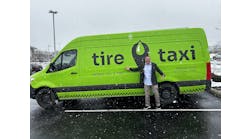A New Year's Resolution Worth Making: Charge for the Value You Deliver
Here’s a challenge to kick off the new year. Name a single consumer good that hasn’t gone up in price over the last several months. (Cue the “final Jeopardy” countdown song.) Can’t think of one? Same here.
Just look at our industry. Tire manufacturers announced 44 separate pricing actions during 2021. Several additional tire price hikes took place earlier this month. And those are the only ones that have been publicly announced. I’m sure there have been more.
Inventory, equipment, personnel, rent, insurance, taxes — the costs associated with running your business are not declining. What’s your plan to combat this?
As I see it, tire dealers with the brightest futures realize that they need to adjust their pricing to absorb the cost of inflation. Simply put, the moment you take possession of tires — or any product — at an increased price, you must pass that increase onto your customers immediately. (MTD’s columnists have advised doing this for years.)
I recently had an opportunity to gain insight from Dave Crawford, who leads franchise operations for Tire Discounters Inc., one of the country’s fastest growing independent tire dealerships. He says the solution to dealing with rising costs is simple — start charging what you’re worth. In other words, it’s time to raise prices for your services.
Crawford, who has nearly 40 years of automotive aftermarket experience, says many tire dealers are undercharging for the services, expertise and products they deliver.
“Most small independent dealers are wearing many hats. They have to focus on day-to-day activities and seldom have time to do things like shop the competition or scrub prices, like the large regional and national players do. “Our days are hectic. That makes it easy to get in a rut or comfort zone and not realize how much money we leave on the table.”
Does this sound familiar?
Crawford says dealers frequently undercharge when it comes to tire and wheel installation packages, shop supplies (“if they charge for this at all”), road hazard plans and “most services. And many underestimate the cost of jobs when giving estimates for services because they are hesitant to sell a big ticket.”
The fear is that price hikes will alienate current customers and scare off potential ones. But this concern is overblown, according to Crawford.
“In reality, customers only price shop a few, selected products and services, like tires, brakes, oil and filters and alignments,” he says.
“Recently, we were talking with a large-volume dealer whose prices were below what they should be. He knew it and had been slow to react. The following month, he raised alignment, oil and brake prices $10 each and dumped a sizable, additional profit in the bank. And he didn’t lose a single customer.”
Furthermore, Crawford argues that most customers won’t notice if you bump up your service rate. “I don’t believe the vast majority of customers ever ask what the labor rate is. They only care about what the end price to fix a problem is. They define value as the total price, out the door.”
If someone calls and asks about your service rate, “it’s probably the competition shopping you.”
Crawford also says you don’t have to enact a dramatic, one-time price hike. “If raising prices or rates becomes part of your ongoing routine, increases can be smaller and (can happen) more often.”
The end result, he adds, “is basically the same.”
In addition, resist the urge to feel like you’re taking advantage of loyal customers by charging more for what you deliver, he advises.
“Dealers go in business to make a profit, yet they are afraid of asking for a fair price, in many cases,” notes Crawford.
“Everything goes up, so it’s important to run the numbers. One just can’t pay the bills and hope the checking account balance stays within a certain range. If you do, you will slowly squeeze your own profits.
“Do your homework to see what the market is charging, decide what the increase will be, make up your mind and start charging more immediately. And make sure your employees are aware of the increases and expectations to sell at new prices.”
New year’s resolutions aren’t always easy to keep. What sounds doable in January might not be as easy to maintain six months down the road.
Charging for the true value that you deliver, however, is one resolution that’s worth making and keeping.
You do a lot of things for other people. It’s time to do something for yourself. Both Dave Crawford and I urge you to go for it in 2022.


